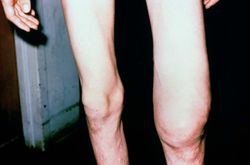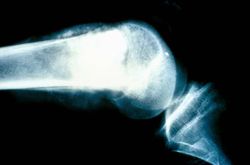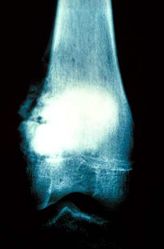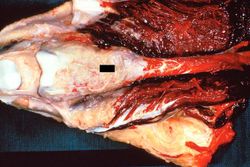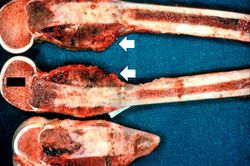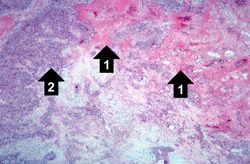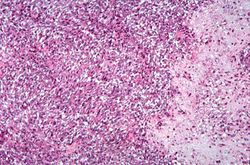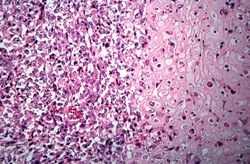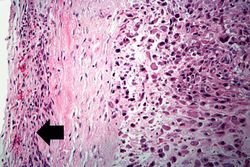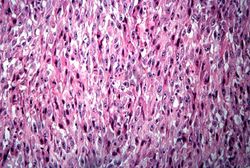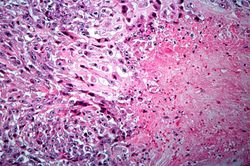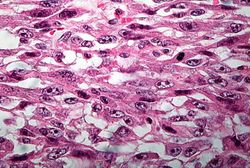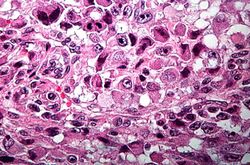Difference between revisions of "IPLab:Lab 7:Osteosarcoma"
Seung Park (talk | contribs) |
Seung Park (talk | contribs) |
||
| (7 intermediate revisions by the same user not shown) | |||
| Line 23: | Line 23: | ||
File:IPLab7Osteosarcoma15.jpg|This is a high-power photomicrograph of the tumor demonstrating the anaplastic cell morphology and multiple mitotic figures (arrows). | File:IPLab7Osteosarcoma15.jpg|This is a high-power photomicrograph of the tumor demonstrating the anaplastic cell morphology and multiple mitotic figures (arrows). | ||
</gallery> | </gallery> | ||
| + | |||
| + | == Virtual Microscopy == | ||
| + | <peir-vm>IPLab7Osteosarcoma</peir-vm> | ||
== Study Question == | == Study Question == | ||
| Line 29: | Line 32: | ||
* <spoiler text="What are some of the risk factors associated with the pathogenesis of osteosarcoma?">Gene mutations are fundamental to the development of osteosarcoma. Patients with hereditary retinoblastomas have a several hundred-fold greater risk of developing osteosarcoma. Mutations in the p53 suppressor gene (Li-Fraumeni syndrome) has been implicated in the development of most nonhereditary osteosarcomas as well as many other types of cancer. Interestingly, many osteosarcomas develop at sites of greatest bone growth where bone cell mitotic activity is at its peak--e.g., the base of the femoral growth plate where primary spongiosa is being formed and in Pagetic bone with its frenzy of bone formation and resorption.</spoiler> | * <spoiler text="What are some of the risk factors associated with the pathogenesis of osteosarcoma?">Gene mutations are fundamental to the development of osteosarcoma. Patients with hereditary retinoblastomas have a several hundred-fold greater risk of developing osteosarcoma. Mutations in the p53 suppressor gene (Li-Fraumeni syndrome) has been implicated in the development of most nonhereditary osteosarcomas as well as many other types of cancer. Interestingly, many osteosarcomas develop at sites of greatest bone growth where bone cell mitotic activity is at its peak--e.g., the base of the femoral growth plate where primary spongiosa is being formed and in Pagetic bone with its frenzy of bone formation and resorption.</spoiler> | ||
* <spoiler text="What is the prognosis for patients with osteosarcoma?">Osteosarcomas are aggressive neoplasms that spread through the bloodstream, and at the time of diagnosis, approximately 20% of patients have demonstrable pulmonary metastases. In those who die of the neoplasm, 90% have metastases to the lungs, bones, brain, and elsewhere. With current treatment regimens the long-term survival rate has been increased to approximately 60% from the historic controls of 25%.</spoiler> | * <spoiler text="What is the prognosis for patients with osteosarcoma?">Osteosarcomas are aggressive neoplasms that spread through the bloodstream, and at the time of diagnosis, approximately 20% of patients have demonstrable pulmonary metastases. In those who die of the neoplasm, 90% have metastases to the lungs, bones, brain, and elsewhere. With current treatment regimens the long-term survival rate has been increased to approximately 60% from the historic controls of 25%.</spoiler> | ||
| + | |||
| + | == Additional Resources == | ||
| + | === Reference === | ||
| + | * [http://emedicine.medscape.com/article/988516-overview eMedicine Medical Library: Pediatric Osteosarcoma] | ||
| + | * [http://www.merckmanuals.com/professional/musculoskeletal_and_connective_tissue_disorders/tumors_of_bones_and_joints/primary_malignant_bone_tumors.html Merck Manual: Primary Malignant Bone Tumors] | ||
| + | |||
| + | === Journal Articles === | ||
| + | * Wittig JC, Bickels J, Priebat D, Jelinek J, Kellar-Graney K, Shmookler B, Malawer MM. [http://www.ncbi.nlm.nih.gov/pubmed/11925089 Osteosarcoma: a multidisciplinary approach to diagnosis and treatment]. ''Am Fam Physician'' 2002 Mar 15;65(6):1123-32. | ||
| + | * Miller SL, Hoffer FA. [http://www.ncbi.nlm.nih.gov/pubmed/11549165 Malignant and benign bone tumors]. ''Radiol Clin North Am'' 2001 Jul;39(4):673-99. | ||
| + | |||
| + | === Images === | ||
| + | * [{{SERVER}}/library/index.php?/tags/797-osteosarcoma PEIR Digital Library: Osteosarcoma Images] | ||
| + | * [http://library.med.utah.edu/WebPath/NEOHTML/NEOPLIDX.html#5 WebPath: Malignant Neoplasms -- Examples of Sarcomas] | ||
{{IPLab 7}} | {{IPLab 7}} | ||
[[Category: IPLab:Lab 7]] | [[Category: IPLab:Lab 7]] | ||
Latest revision as of 16:26, 3 January 2014
Contents
Clinical Summary[edit]
This 14-year-old white male first experienced mild pain in the left knee after playing baseball, approximately two months prior to admission. The pain persisted in an intermittent fashion, and was described as being somewhat worse at night. Approximately two weeks prior to admission, the pain increased significantly and was accompanied by marked swelling and loss of considerable motion of the knee joint. These symptoms were accompanied by a history of decreased appetite, lethargy, and a 10-pound weight loss. On physical examination, the left knee was enlarged diffusely, firm, and non-tender. Following biopsy, the patient was subjected to surgical removal of the distal femur and knee with placement of a prosthetic knee joint and bone grafts.
Autopsy Findings[edit]
The distal diaphysis of the femur and adjacent soft tissues were involved in a 15 x 10 x 10-cm mass. The cut surface of the mass was fleshy white, with focal areas of hemorrhage.
Images[edit]
Virtual Microscopy[edit]
Study Question[edit]
Additional Resources[edit]
Reference[edit]
Journal Articles[edit]
- Wittig JC, Bickels J, Priebat D, Jelinek J, Kellar-Graney K, Shmookler B, Malawer MM. Osteosarcoma: a multidisciplinary approach to diagnosis and treatment. Am Fam Physician 2002 Mar 15;65(6):1123-32.
- Miller SL, Hoffer FA. Malignant and benign bone tumors. Radiol Clin North Am 2001 Jul;39(4):673-99.
Images[edit]
The normal fibrinogen level is 184 to 412 mg/dL.
